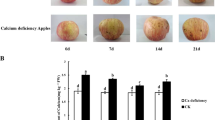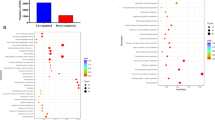Abstract
Potassium (K+) is an essential macronutrient for plant growth, development, and fruit quality and yield. K+ uptake and transport is facilitated by KT/HAK/KUP transporters. However, studies to establish molecular mechanisms are rare in fruits, especially in peaches. In this study, we isolated 16 putative KT/HAK/KUP transporter genes in peach, and analyzed K+ homeostasis status in relation to KUP (K+ uptake) gene expression during whole fruit development life. The ‘**ahui6’ peach development was divided into four distinct stages, S1–S4, and fruits were harvested on 110 days after full bloom (DAFB). qRT-PCR results showed that PpeKUP genes unevenly existed in various fruit parts and are differentially expressed during fruit development, ripening, and postharvest storage. The most highest-expressed gene was PpeKUP1 in mesocarp and PpeKUP2 in skin, especially during early stages, while PpeKUP3 was steadily expressed even until postharvest shelf-life. After harvest, the flesh firmness was nonsignificantly changed under cold treatment (4 °C), to avoid ripening. Notably, five PpeKUP genes were responsive to cold treatment as their expression were mainly induced in skin, except for PpeKUP3 that was decreased in both mesocarp and skin. Moreover, functional determination showed that PpeKUP1 and PpeKUP2 are important K+ transporters that mediate K+ uptake and accumulation, especially during fruit formation and fast growth stages. This study reveals a close relationship among peach growth, firmness maintenance, and K+ homeostasis, and directly provides potential candidate genes for further molecular studies.







Similar content being viewed by others
Abbreviations
- CDS:
-
Coding sequence
- DAFB:
-
Day after full bloom
- E. coli :
-
Escherichia coli
- H:
-
Harvest
- K+ :
-
Potassium
- KT/HAK/KUP:
-
K+ transporter/high-affinity K+ transporter/K+ uptake permease
- qRT-PCR:
-
Quantitative real-time PCR
References
Ashley MK, Grant M, Grabov A (2006) Plant responses to potassium deficiencies: a role for potassium transport proteins. J Exp Bot 57:425–436
Baňuelos MA, Garciadeblas B, Cubero B, Rodríguez-Navarro A (2002) Inventory and functional characterization of the HAK potassium transporters of rice. Plant Physiol 130:784–794
Buurman ET, Kim KT, Epstein W (1995) Genetic evidence for two sequentially occupied K+ binding sites in the Kdp transport ATPase. J Biol Chem 270:6678–6685
Demiral MA, Köseoglu AT (2005) Effect of potassium on yield, fruit quality, and chemical composition of greenhouse-grown Galia melon. J Plant Nutr 28:93–100
Epstein W, Buurman ET, McLaggan D, Naprstek J (1993) Multiple mechanisms, roles and controls of K+ transport in Escherichia coli. Biochem Soc T 21:1006–1010
Fu HH, Luan S (1998) AtKuP1: a dual-affinity K+ transporter from Arabidopsis. Plant Cell 10:63–73
Grabov A (2007) Plant KT/KUP/HAK potassium transporters: single family—multiple functions. Ann Bot Lond 99:1035–1041
Gupta M, Qiu X, Wang L, **e W, Zhang C, **ong L, Lian X, Zhang Q (2008) KT/HAK/KUP potassium transporters gene family and their whole-life cycle expression profile in rice (Oryza sativa). Mol Genet Genomics 280:437–452
Hartz TK, Johnstone PR, Francis DM, Miyao EM (2005) Processing tomato yield and fruit quality improved with potassium fertigation. Hort Sci 40:1862–1867
Jung S, Staton M, Lee T, Blenda A, Svancara R, Abbott A, Main D (2008) GDR (Genome Database for Rosaceae): integrated web-database for Rosaceae genomics and genetics data. Nucleic Acids Res 36:D1034–D1040
Layne DR, Bassi D (2008) The peach: botany, production and uses. CABI, London
Lebaudy A, Very AA, Sentenac H (2007) K+ channel activity in plants: genes, regulations and functions. FEBS Lett 581:2357–2366
Lester GE, Jifon JL, Makus DJ (2010) Impact of potassium nutrition on postharvest fruit quality: melon (Cucumis melo L) case study. Plant Soil 335:117–131
Lombardo VA, Osorio S, Borsani J, Lauxmann MA, Bustamante CA, Budde CO, Andreo CS, Lara MV, Fernie AR, Drincovich MF (2011) Metabolic profiling during peach fruit development and ripening reveals the metabolic networks that underpin each developmental stage. Plant Physiol 157:1696–1710
Mäser P, Thomine S, Schroeder JI, Ward JM, Hirschi K, Sze H, Talke IN, Amtmann A, Maathuis FJ, Sanders D, Harper JF, Tchieu J, Gribskov M, Persans MW, Salt DE, Kim SA, Guerinot ML (2001) Phylogenetic relationships within cation transporter families of Arabidopsis. Plant Physiol 126:1646–1667
Mian A, Oomen RJ, Isayenkov S, Sentenac H, Maathuis FJ, Véry AA (2011) Over-expression of an Na+-and K+-permeable HKT transporter in barley improves salt tolerance. Plant J 68:468–479
Nava G, Dechen AR, Nachtigall RG (2007) Nitrogen and potassium fertilization affect apple fruit quality in Southern Brazil. Commun Soil Sci Plant 39:96–107
Rigas S, Debrosses G, Haralampidis K, Vicente-Agullo F, Feldmann KA, Grabov A, Dolan L, Hatzopoulos P (2001) Trh1 encodes a potassium transporter required for tip growth in Arabidopsis root hairs. Plant Cell 13:139–151
Rubio F, Santa-Maria GE, Rodriguez-Navarro A (2000) Cloning of Arabidopsis and barley cDNAs encoding HAK potassium transporters in root and shoot cells. Physiol Plant 109:34–43
Santa-Maria GE, Rubio F, Dubcovsky J, Rodriguez-Navarro A (1997) The HAK1 gene of barley is a member of a large gene family and encodes a high-affinity potassium transporter. Plant Cell 9:2281–2289
Senn ME, Rubio F, Banuelos MA, Rodriguez-Navarro A (2001) Comparative functional features of plant potassium HvHAK1 and HvHAK2 transporters. J Biol Chem 276:44563–44569
Song ZZ, Su YH (2013) Distinctive potassium-accumulation capability of alligatorweed (Alternanthera philoxeroides) links to high-affinity potassium transport facilitated by K+-uptake systems. Weed Sci 61:77–84
Song ZZ, Yang SY, Zhu H, ** M, Su YH (2014) Heterologous expression of an alligatorweed high-affinity potassium transporter gene enhances salinity tolerance in Arabidopsis. Am J Bot 101:840–850
Song ZZ, Ma RJ, Yu ML (2015a) Genome-wide analysis and identification of KT/HAK/KUP potassium transporter gene family in peach (Prunus persica). Genet Mol Res 14:774–787
Song ZZ, Yang Y, Ma RJ, Yu ML (2015b) Transcription of potassium transporter genes of KT/HAK/KUP family in peach seedlings and responses to abiotic stresses. Biol Plantarum 59:65–73
Tong ZG, Gao ZH, Wang F, Zhou J, Zhang Z (2009) Selection of reliable reference genes for gene expression studies in peach using real-time PCR. BMC Mol Biol 10:71
Vallejo AJ, Peralta ML, Santa-Maria GE (2005) Expression of potassium-transporter coding genes, and kinetics of rubidium uptake, along a longitudinal root axis. Plant Cell Environ 28:850–862
Véry AA, Sentenac H (2003) Molecular mechanisms and regulation of K+ transport in higher plants. Annu Rev Plant Biol 54:575–603
Wang YH, Garvin DF, Kochian LV (2002) Rapid induction of regulatory and transporter genes in response to phosphorus, potassium, and iron deficiencies in tomato roots. Evidence for cross talk and root/rhizosphere-mediated signals. Plant Physiol 130:1361–1370
Yu ML, Ma RJ, Du P, Song HF, Shen ZJ, Zhang Y, Xu JL (2005) Breeding report on mid-season peach cultivar–**ahui 6. J Fruit Sci 22:298–299 (in Chinese)
Yurtseven E, Kesmez GD, Ünlükara A (2005) The effects of water salinity and potassium levels on yield, fruit quality and water consumption of a native central anatolian tomato species (Lycopersicon esculantum). Agr Water Manag 78:128–135
Zhao D, Oosterhuis DM, Bednarz CW (2001) Influence of potassium deficiency on photosynthesis, chlorophyll content, and chloroplast ultrastructure of cotton plants. Photosynthetica 39:103–109
Acknowledgments
This work was supported by the grants from China Agriculture Research System (CAR-31), Jiangsu Agriculture Science and Technology Innovation Fund (CX(14)2015), and China Postdoctoral Scientific Research Foundation (2015M571713).
Author information
Authors and Affiliations
Corresponding author
Additional information
Communicated by P. K. Nagar.
Z. Song and S. Guo contributed equally to this work.
Electronic supplementary material
Below is the link to the electronic supplementary material.
11738_2015_1880_MOESM2_ESM.tif
Supplemental Fig. 1 Deduced amino acid sequence alignment of PpeKUP proteins. Accession Nos. of these KUP transporters are shown in Supplemental Table 1. (TIFF 686 kb)
11738_2015_1880_MOESM3_ESM.jpg
Supplemental Fig. 2 Differential expression of KUP family genes during fruit development and ripening. Relative expression of KUP family genes in mesocarp (A) and skin (B). Fruit samples were collected every 20 days, starting from 20 DAFB to harvest (110 DAFB). Both the skin and the mesocarp were used for qRT-PCR examination. Relative expression values are given as ratio relative to the values of Ubiquitin. Data are means of values obtained from three replicates, using independent RNAs as templates. (JPEG 1439 kb)
Rights and permissions
About this article
Cite this article
Song, Z., Guo, S., Zhang, C. et al. KT/HAK/KUP potassium transporter genes differentially expressed during fruit development, ripening, and postharvest shelf-life of ‘**ahui6’ peaches. Acta Physiol Plant 37, 131 (2015). https://doi.org/10.1007/s11738-015-1880-1
Received:
Revised:
Accepted:
Published:
DOI: https://doi.org/10.1007/s11738-015-1880-1




